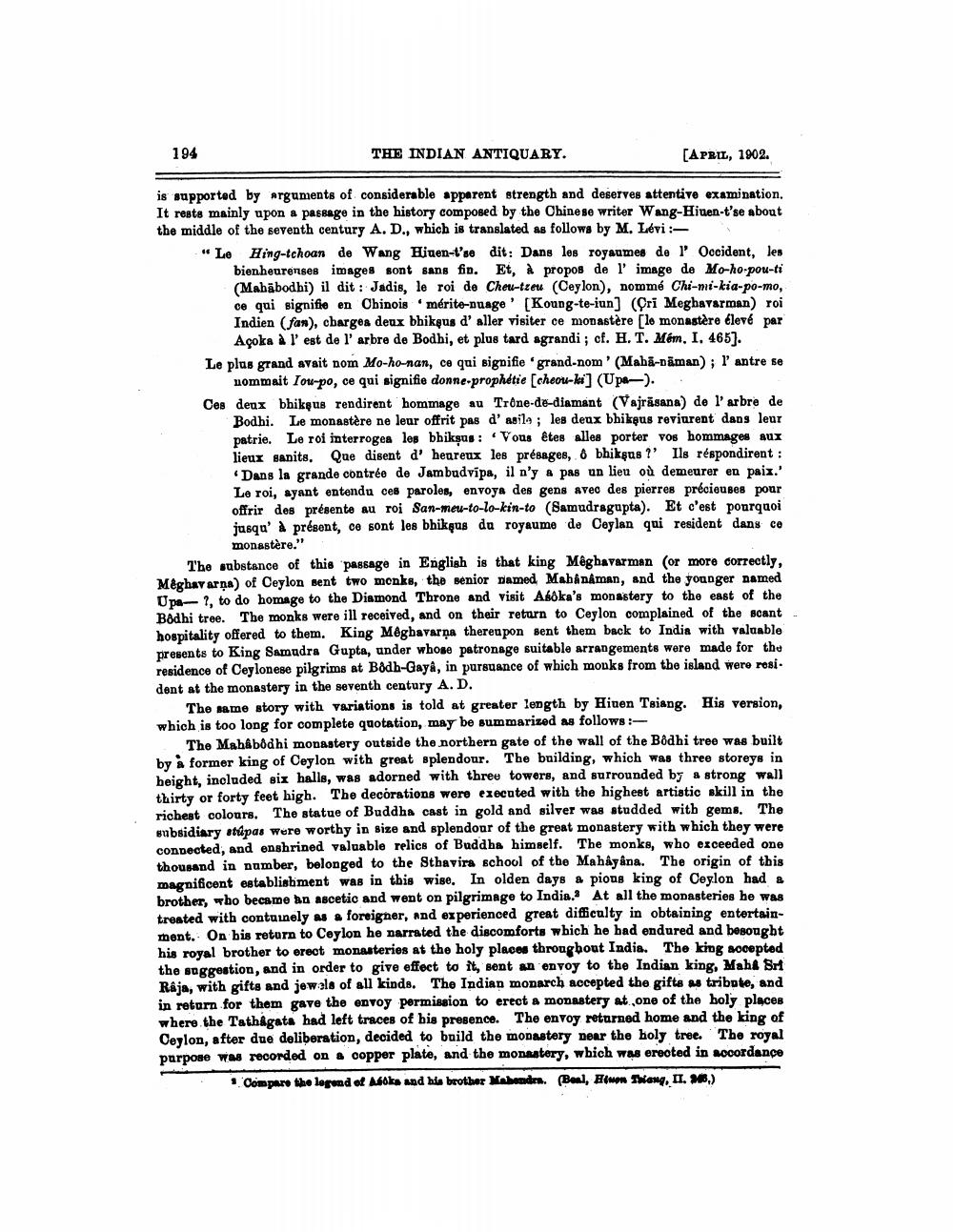________________
194
THE INDIAN ANTIQUARY.
[APRIL, 1902.
is supported by arguments of considerable apparent strength and deserves attentive examination, It rests mainly upon a passage in the history composed by the Chinese writer Wang-Hinen-t'se about the middle of the seventh century A. D., which is translated as follows by M. Lévi :
"Le Hing-tchoan de Wang Hiuen-t'se dit: Dans les royaumes de l'Occident, les
bienheurenses images sont sans fin. Et, à propos de l'image de Mo-ho-pou-ti (Mahābodbi) il dit : Jadis, le roi de Cheu-treu (Ceylon), nommé Chi-ni-kia-po-mo, ce qui signifie en Chinois mérite-Duage' [Koung-te-iun) (Pri Meghavarman) roi Indien (fan), cbarges deux bbikgus d'aller visiter ce monastère [lo monastère élevé par
Açoka à l'est de l'arbre de Bodhi, et plus tard agrandi; cf. H. T. Mém. I. 465). Le plus grand avait nom Mo-ho-nan, ce qui signifie 'grand-nom' (Mahi-näman); l'antre se
nommait Tou-po, ce qui signifie donne-prophétie (cheou-ki] (Upa ). . Ces deux bhikous rendirent hommage au Trône-de-diamant (Vajrasana) de l'arbre de
Bodhi. Le monastère ne leur offrit pas d'asila ; les deux bhikpus reviurent dans leur patrie. Le roi interrogea les bhikṣus : Vous êtes alles porter vos hommages aux lieux sanits. Que disent d'heureux les présages, 6 bhikṣus ?' Ils respondirent :
Dans la grande contrée de Jambudvipa, il n'y a pas un lieu où demeurer en paix.' Le roi, ayant entendu ces paroles, envoya des gens avec des pierres précieuses pour offrir des présente au roi San-meu-to-lo-kin-to (Samudragupta). Et c'est pourquoi jusqu'à présent, ce sont les bhikçus du royaume de Ceylan qui resident dans ce
monastère." The substance of this passage in English is that king Mêghavarman (or more correctly, Méghavarna) of Ceylon sent two monks, the senior Damed Mahanaman, and the younger named Up ?, to do homage to the Diamond Throne and visit Ashka's monastery to the east of the Bodhi tree. The monks were ill received, and on their return to Ceylon complained of the scant hospitality offered to them. King Mêgbavarņa thereu pon sent them back to India with valuable presents to King Samudra Gupta, under whose patronage suitable arrangements were made for the residence of Ceylonese pilgrims at B8db-Gayâ, in pursuance of which monks from the island were rosi. dent at the monastery in the seventh century A.D.
The same story with variations is told at greater length by Hinen Teiang. His version, which is too long for complete quotation, may be summarized as follows:
The Mahabodhi monastery outside the northern gate of the wall of the Bodhi tree was built by å former king of Ceylon with great splendour. The building, which was three storeys in height, included six halls, was adorned with three towers, and surrounded by a strong wall thirty or forty feet high. The decorations were executed with the highest artistic skill in the richest colours. The statue of Buddha cast in gold and silver was studded with gems. The subsidiary stúpas were worthy in size and splendour of the great monastery with which they were connected, and enshrined valuable relics of Buddha himself. The monks, who exceeded one thousand in number, belonged to the Sthavira school of the Mahayana. The origin of this magnificent establishment was in this wise. In olden days & pions king of Ceylon had & brother, who became an ascetic and went on pilgrimage to India. At all the monasteries he was treated with contuinely a foreigner, and experienced great difficulty in obtaining entertainmont. On bis return to Ceylon he narrated the discomforts wbich he had endured and besought his royal brother to sreot monasteries at the holy places througbout India. The king accepted the suggestion, and in order to give effect to it, sent an envoy to the Indian king, Maha Sri Raja, with gifts and jewels of all kinds. The Indian monarch accepted the gifts as tribote, and in return for them gave the envoy permission to erect a monastery at one of the holy places where the Tathagata had left traces of his presence. The envoy returned home and the king of Ceylon, after due deliberation, decided to build the monastery near the holy tree. The royal purpose was recorded on a copper plate, and the monastery, which was erected in accordance
Compare the legend of Afbka and his brother Mahendra. (Boul, Homon Thang, II. 24.)




